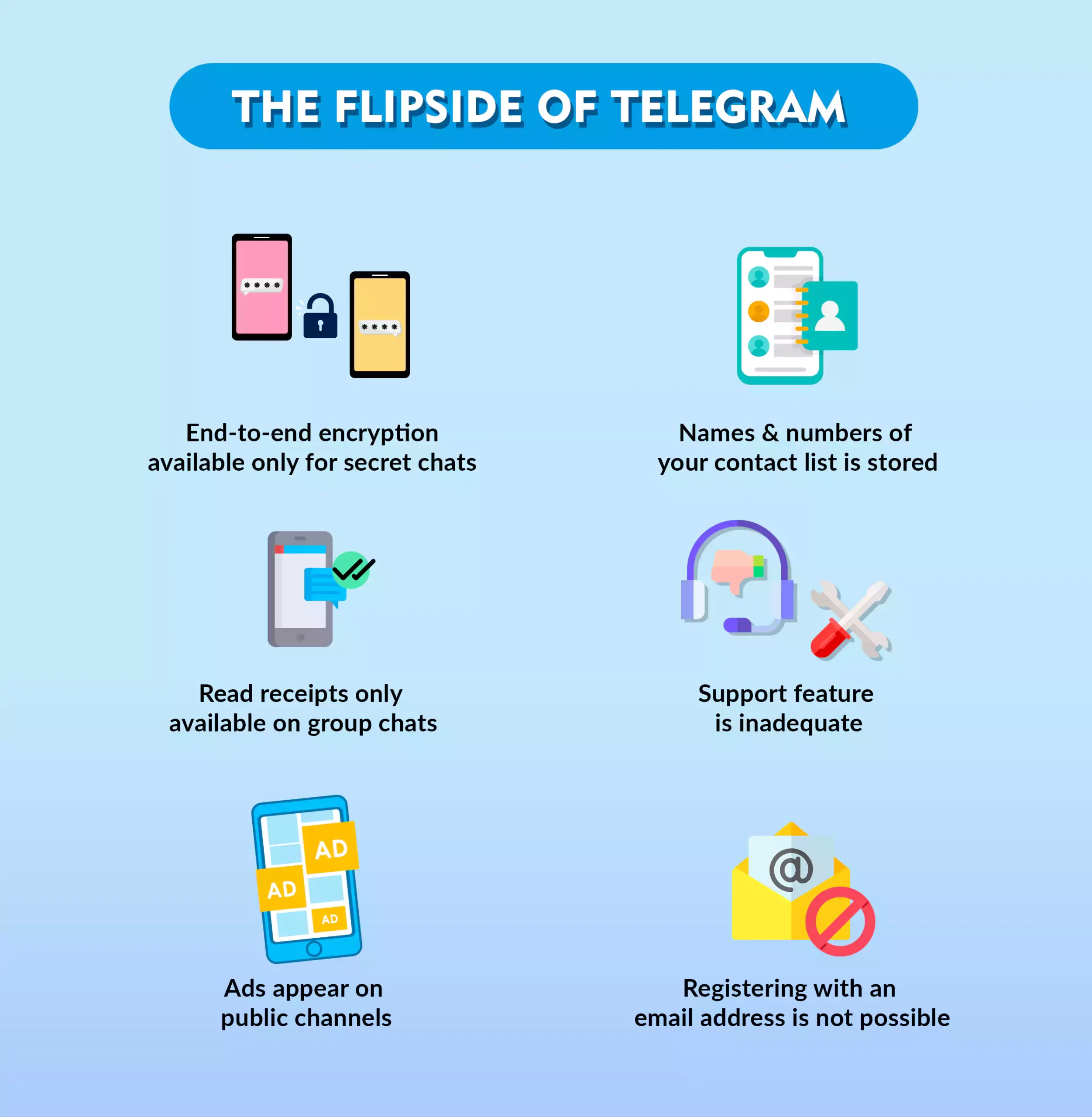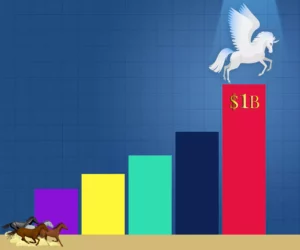
In January 2021, WhatsApp declared changes in its privacy policy. As a result, user data from WhatsApp was about to be shared with Facebook, which drew severe backlash. This collective outrage manifested as millions of uninstallations of the app. And that’s when Telegram entered the scene. Telegram, a cloud-based storage application, became a fast favourite among those abandoning WhatsApp. This app, relatively unknown till then, was created by Parel Durov. He is also the creator behind VKontakte, Russia’s most popular social networking platform. As people began deleting Whatsapp from their phones, Telegram gained 500 million monthly users. Currently, this surge has somewhat plateaued. However, the app has nonetheless positioned itself as a worthy contender. So what prompted users to make room on their devices for Telegram? We unfold the reasons here.
Telegram’s top features
To keep the customers glued and attract other potential audiences, Telegram adds new features and functions every month. And as we are generally inclined to customisation and personalisation, Telegram is doing its best to make those happen with the app.
Here are some ways in which Telegram achieves this:
- Auto-delete: This feature allows users to automatically delete chats by establishing adjustable timers that could be days, weeks, or months.
- Custom notifications: You can generate custom alerts for each chat with a simple tap-and-select. You can quickly add the file to your list of notification sounds, from music to a quick audio file or even a voice message.
- Independent chat settings: Users have the liberty to set a custom duration for temporarily muting chats. They can modify each chat by disabling notification alerts to mute or turn it off totally.
- Regulating forwarded messages: This allows a user to hide their account link from being displayed when someone else forwards the user’s message.
- Picture-in-picture mode: When this is activated, users can view videos while accessing other app functions.
What makes it a more secure and personal platform?
The highly echoed USP of this app is the security it claims to offer. How? These features certainly help:
- Encryption: Telegram is one of the world’s most secure P2P messaging platforms, and this legacy has carried on since its inception. Here, your chats are encrypted, and the app will not use them for any marketing activity.
- Report messages: In the latest reporting system, users can report any spam content, pornography, fraudulent accounts, violence, child abuse, etc., by selecting a specific message. The user must add a comment to the reporting options to support their allegation to take down that content.
- Convenience: Telegram has invite links that can be converted to QR codes and printed if required. These links help admins see where most new users are coming from, as it aids in tracking the channel’s performance and growth. It also enables the scheduling of messages.
- Sorting: You can sort the clutter and organise chats using chat folders when you have too many communication channels on Telegram.
- Accessibility: One can access messages from many devices at the same time. It also includes a personal ‘Saved Messages’ section that you can use as a journal to note important messages or save photographs and chats. Telegram will back up these messages on the cloud. Additionally, you can send media files up to 2GB. However, paid subscribers can send 4 GB files or 18 days of high-quality audio.
- Broadcast groups: These are community-based groups where only the admins are allowed to send messages. All members can join the live voice chat for audio conversations. It is a perfect hub for huge communities since it enables people to follow along and listen to exclusive interviews, news, and sessions.
How does Telegram benefit online businesses?
Before jumping into how businesses leverage Telegram to drive sales, let’s talk about its audience base. Recently, Telegram surpassed an audience base of 700 million, and its customer base is aged 25 to 34 (30.6%). Its usage by other age categories is roughly similar. From these statistics, we can understand that Telegram owns a mature audience that understands the software.
Now, let’s understand how businesses access this cloud-based platform to engage and own a community for the brand.
- Engagement: According to experts, Telegram has a 20% view rate, whereas Instagram has a view rate of a mere 3%, and Facebook comes in with 4%. Telegram has higher engagement since it offers gifs. And its use of Application Programming Interface (API) allows developers to design their programmes on the platform.
- Increased reach: While Whatsapp restricts its group size to 200, Telegram has no such restrictions. Thus, Telegram offers a broader reach for your brand.
- More secure: With growing worries about WhatsApp’s privacy, Telegram has become a more secure platform. The app offers hidden or secret chats for people to discuss business and communicate within teams.
- Telegram pods: Businesses can leverage these to generate alerts and engage audiences. Instead of someone personally sending out continuous reminders to groups, the bots do it automatically.

Telegram encryption and security
Telegram’s personal and community chats use client-server encryption. Their secret chat feature is the only option to employ end-to-end (E2E) encryption. Secret chat messages are E2E encrypted, which is good, but regular chat messages are not. It implies that Telegram encrypts non-secret messages on your gadget before being decoded on their server. These messages are then again encrypted on the server before being delivered to the user’s device for complete decryption.
Telegram employs its own MTProto, a proprietary encryption mechanism for user data. It collects and stores your phone number for account authentication, username, and contact details. Furthermore, they may collect and retain your metadata, such as IP address, device details, and history of Telegram username changes, for a year.
They claim to control message storage and decryption algorithms, so accessing any of your data will require a lot of legal obligations.
They also claim to have exchanged 0 bytes of data with other third parties and governments. Even if you use secret chats, the app encrypts your messages using its self-built encryption protocol, MTProto.
Security breach
In 2019, during the Hong Kong mass protest, security vulnerabilities in the app allowed the government to sabotage its privacy features to suppress the protest. These security breaches prompted Telegram to create a new feature that allows users to mask their phone numbers.
In mid-2020, the app suffered a data leak, exposing user information to the darknet. The app, in its defence, claimed that most of this data was outdated. Additionally, they issued a statement explaining that all similar contact-based apps are vulnerable to similar attacks by malicious actors.
The role of Telegram during political conflicts
Telegram has become a platform for people, especially when dealing with tyranny and information exchange from a global perspective.
In 2020, citizens in Belarus opposed Russia-backed authoritarian leader Alexander L. and utilised this application to organise a 1,00,000-person mass protest. Moreover, Ukrainian President Zelenskyy publicly urged men to stand up and fight the invasion via Telegram.
During the Kremlin’s crackdown, many Russians switched to Telegram to leverage unbiased information. And Ilya Varlamov, a Russian journalist, used it to stream the invasion live.
The privacy provided by Telegram can also act as an aggregator of havoc. For example, regarding the recent friction between Ukraine and Russia, the latter government administered Telegram for state-affiliated news outlets such as Sputnik and RT news. It pushed individuals to switch to the platform for pro-Kremlin content.
Telegram, by its own admission, has its flaws. Nevertheless, since its launch in 2013, the app has added to the function of global accessibility. What remains to be seen is whether it steadily delivers on its claims in the next few years, especially in its promise of heightened security.


